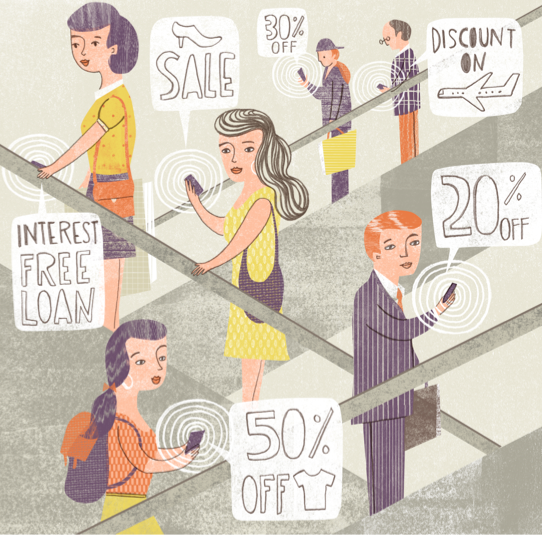
Goodbye, QR and NFC. Hello, iBeacon, with your ray of technological light.
It doesn’t seem that long ago everyone was touting near field communication (NFC) as the hottest thing in smartphone connectivity. It was the QR code killer, the new way to push deals to overloaded consumers.

ILLUSTRATION: Angela Keoghan?
Now NFC is like, so last year. And the QR code might as well be etched on a cave wall. The shiny new poster child is the beacon, whose powers include the potential to transform the way we shop, to fuse the virtual world with the physical and herald new ways of passing data between devices.
The path to this world of wonder has been paved by Apple, which introduced iBeacon to its operating system in 2013. Using Bluetooth Low Energy (LE) connectivity, different types of software and hardware locate mobile devices indoors and can be used to send notifications to users. Newer Android devices also support Bluetooth LE.
Retail is the obvious sweet spot and some big offshore outfits are trialing sending news and offers to people in their stores, based on where the target consumer is standing. But there are big possibilities outside the shop front. Among Apple’s many patent filings is a system to tap into iBeacon to serve diners with restaurant options, menus and available seating.
The scope for airports and transport stations to provide maps using iBeacon are also obvious. And imagine beacons playing tour guide as you check out a museum or gallery.
Everything above centres around a seller or information provider pushing something to a mobile. But it’s important to remember Apple and Android devices themselves can act as beacons, which opens new realms of communication between people, based on their proximity to each other. I’m thinking of more powerful ways to recommend, review and share, rather than creepy ways to ask for a date.
Beacons are casting a shadow over other location-based technology. We’re used to GPS tracking us, but its usefulness generally ends at the building entrance. NFC needs its chips to be in especially close range before it works, but Bluetooth Low Energy works within 50 metres and won’t drain your phone battery like GPS.
Beacon startups are shining. In the US Estimote – which calls its beacon hardware ‘motes’ – recently got $3.1 million in funding. Sensorberg is flying the beacon flag in Europe. While still at the Microsoft Ventures Accelerator
in Berlin, it attracted 750,000 Euros of angel investment. As well as pushing its sensors to retailers, its software development kit opens the way for app developers to and marketers to create their own offerings.
Closer to home, Australian-owned Westpac is an early iBeacon trialist in New Zealand.
With so much going for the technology, what’s standing in the way of adoption? You could be excused for feeling like this is a tool for spying. If my phone is the new target of the location-aware daily deal, will I ever be left to shop in peace? And what’s being sucked from my mobile into the retailers’ stash of weapons to stalk buyers?
The answer to the first question is no, you won’t be left alone. The advance of tech like this is inexorable. The answer to the second is nothing you choose to keep private because beacons don’t rely on the interweb.
What may kill the trend towards widespread use is the arrival of the next big thing. Some mobile device makers bet their hand on NFC, now it’s far from a sure winner. But this transience is at the heart of technological innovation. Beacons are a light worth following, for the time being, at least.




